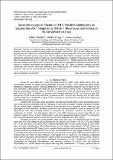| dc.contributor.author | Lilian Owoko, Charles Olang‟o , Benson Nyambega | |
| dc.date.accessioned | 2022-02-04T12:57:13Z | |
| dc.date.available | 2022-02-04T12:57:13Z | |
| dc.date.issued | 2019 | |
| dc.identifier.issn | : 2279-0837 e : 2279-0845.p | |
| dc.identifier.uri | https://repository.maseno.ac.ke/handle/123456789/4881 | |
| dc.description.abstract | Globally, HIV-related deaths declined by 30% between 2005 and 2012 among children and adults.
However, those among adolescents living with HIV (ALHIV) rose by 50%. This has been influenced by late
diagnosis and poor adherence to antiretroviral therapy (ART). Socio-demographic factors most often are beyond
the control of ALHIV yet they may expose them to situations that influence adherence to ART. This study
explored the relationship between gender, age, household background, institution of learning and orphanhood
status and adherence among 15-19 year old ALHIV on second-line ART. Results showed that: female ALHIV
were more adherent than male ALHIV irrespective of age; both day and boarding institutions of learning did not
provide an enabling environment that supported adherence; age, ART status of primary caregiver and their
relationship with ALHIV influenced adherence and finally double and maternal orphans exhibited poor
adherence. Core was the interplay between these factors as discussed. | en_US |
| dc.publisher | IOSR Journal Of Humanities And Social Science (IOSR-JHSS) | en_US |
| dc.title | Socio-demographic Factors of HIV-Positive Adolescents on Second-line ART Regimen and their Influence on Adherence in Rural Western Kenya | en_US |
| dc.type | Article | en_US |

